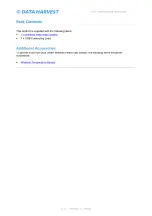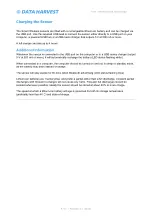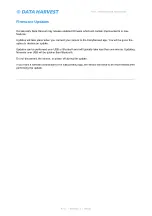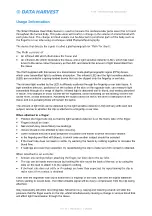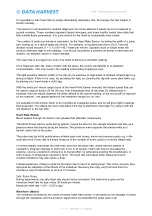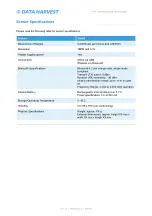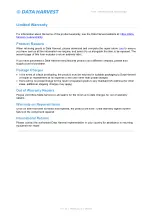
1156 - Wireless Heart Rate Sensor
11 / 21 | Revision: 0 | DS033
It is possible to alter heart rate by simply decreasing respiratory rate. Encourage the test subject to
breath normally.
This sensor is not intended for medical diagnosis. Do not be alarmed if results do not correspond to
quoted numbers. These numbers represent typical averages, and many healthy hearts have data that
falls outside these parameters. It is quite normal for the heart to occasionally miss a beat.
The number of beats per minute is calculated, by the Heart Rate Sensor, by timing the width of a pulse
and ‘scaling up’ to a rate of beats per minute. For example, a recorded wave form of a 0.7 second
duration would become (1 ÷ 0.7) x 60 = 85.7 beats per minute. Sporadic short or longer beats will
produce artificially high or low readings. This should not present a problem as trends in heart rate are
studied, not absolute values or rapid changes.
The heart rate is averaged over every five beats to achieve a smoother reading.
If the finger/ear lobe clip ‘loses contact’ with the pulse, the sensor will attempt to re-establish
communication. This may result in the reading momentarily dropping to zero. .
The light sensitive detector (LSD) in the clip can be sensitive to high-levels of ambient infrared light e.g.
strong sunlight. If this is the case, try excluding the light, by covering the clip with some dark fabric e.g.
by placing your hand inside a cloth bag.
With the beats per minute range (bpm) of the Heart Rate Sensor selected, the fastest speed that can
be used to capture data is 50 Hz (20 ms). If an intersample time of less than 20 milliseconds is
selected, then the values obtained will either default to the lowest reading, or the set-up will be rejected
by the software. This fastest speed for the Waveform range (mV) is 1ms.
It is possible for the dicrotic notch to be recorded as a separate pulse, and so will give higher readings
than expected. The effects are more noticeable if the clip is attached to the finger; try using it with the
clip attached to the ear lobe.
Heart Rate (Notes)
Blood passes through the heart in two phases that alternate continuously.
The blood forced into the aorta during systole, moves the blood in the vessels forwards and sets up a
pressure wave that travels along the arteries. This pressure wave expands the arterial walls as it
travels, and is felt as the pulse.
The pulse may be felt at points where arteries pass over bones, known as pressure points e.g. in the
wrist and neck. Pulse rate is a direct measure of the number of heart cycles in a minute (heart rate).
In normal healthy individuals the heart rate, and thus the pulse rate, varies with the phases of
respiration. Irregular changes in heart rate occur in all people. Heart rate may be increased by
exercise, nervous excitement, stress due to mental effort, by adrenaline entering the bloodstream, or
with increase in temperature caused by fever. The heart rate decreases when asleep and some
medical conditions may also cause a drop.
Following exercise, it takes a while for the heart rate to return to resting level. This is the recovery time
and gives an indication of the fitness of the individual. Recovery time may vary from less than five
minutes in very fit individuals, to around 15 minutes.
Safe Pulse Rates
During experiments, the safe heart rate should not be exceeded. The safe level is given as the
maximum heart rate for age, minus 20 beats per minute
Maximum heart rate = 210 – (0.65 x age)
Waveform (Notes)
The heartbeat recorded by the Smart Wireless Heart Rate sensor is smoothed by the passage of blood
through the capillaries, and the pressure signal does not resemble the pulse seen in an




